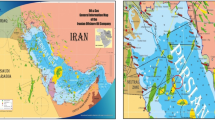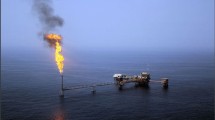Abstract
Due to its sensitive geopolitical situation as well as giant oil and gas fields, the Persian Gulf has exceptional environmental conditions. However, it is one of the most polluted maritime zones because of strategic sensitivities that have consistently led to political and military tensions, enormous economic resources and marine structures for natural resource extraction. Given the importance of the marine environment, the lack of comprehensive resource monitoring and management and pollution control plan results in environmental degradation. Oil and gas piers are one of the most common offshore structures that may be deteriorated and lead to human and financial losses as well as irreparable environmental impacts. Therefore, damage detection in the early stages of marine structure development is of great importance. The modal strain energy is a non-destructive damage detection method for concrete structures that estimates the damage localization or severity by changing the dynamic properties of the structure. Making some corrections to the previous versions of the modal strain energy method, this study aims to estimate the damage location and severity of a real sample of pile-deck LPG pier in the South Pars Gas Field (Assaluyeh) of Persian Gulf numerically and experimentally. Results showed that the present method has higher accuracy in locating damages than the other methods. Also, single and multiple damages of low and high severity were estimated by this method with good accuracy.














Similar content being viewed by others
References
Akyuz E, Celik M (2015) Application of CREAM human reliability model to cargo loading process of LPG tankers. J Loss Prev Proc Ind 34:39–48. https://doi.org/10.1016/j.jlp.2015.01.019
Al-Fozan SA, Malik AU (2008) Effect of seawater level on corrosion behavior of different alloys. Desalination 228(1–3):61–67. https://doi.org/10.1016/j.desal.2007.08.007
Asgarian B, Gholami H, Gharebaghi SA (2018) A probabilistic model for uniform corrosion in offshore steel structures in Persian Gulf. J Mar Eng 13(26):59–70
Balageas D (2010) Introduction to structural health monitoring. In: Balageas D, Fritzen CP, Güemes A (eds) Structural health monitoring. Wiley-ISTE, pp 13–44
Biklaryan M, Lotfollahi-Yaghin MA, Aminfar MH, Mojtahedi A (2014) Investigation into the uncertainty parameters in dynamics performance of pier stochastic finite element method using Wishart random matrix. J Mar Eng 19:1–11
Chandrasekaran S, Kumar PTA (2019) Damage detection in reinforced concrete berthing jetty using a plasticity model approach. J Mar Sci Appl 18:482–491. https://doi.org/10.1007/s11804-019-00108-3
Dousti A, Moradian M, Taheri SR, Rashetnia R (2013) Corrosion assessment of RC deck in a jetty structure damaged by chloride attack. J Perform Constr Facil 27(5):519–528. https://doi.org/10.1061/(ASCE)CF.1943-5509.0000348
El-Reedy MA (2012) Corrosion Protection. In: Offshore structures: design, construction and maintenance, 1st edn. Gulf Porfessional Publishing, pp 383–444
Gholipour-Feizi M, Nourani V, Mojtahedi A, Barghian M (2017) Evaluating the uncertainties in the semi-rigidity of conncections of the pire base to optimization of finite element model updating. Modares Mech Eng 16(12):281–290
Hao Z, Qing-ji J, Li-fang L, Xi S (2011) Case based structural health monitoring analysis of Chun Xian Wharf in Hangzhou. In: International conference on electric technology and civil engineering (ICETCE). https://doi.org/10.1109/ICETCE.2011.5775795
Hu H, Wu C (2009) Development of scanning damage index for the damage detection of plate structures using modal strain energy method. Mech Syst Signal Process 23(2):274–287. https://doi.org/10.1016/j.ymssp.2008.05.001
Huang C, Wei Z (2009) Research on structural health monitoring of seaport wharf. In: Yuan Y, Cui J, Mang HA (eds) Computational structural engineering. Springer, pp 1291–1299
Izadi A, Dobaradaran S, Nabipour I, Mahvi AM, Abedi E, Keshtkar M (2017) The fluoride and chloride ion levels in the seawater along the northern part of the Persian Gulf in Bushehr province, Iran. Res Rep Fluoride 50(1):127–134
Kim JT, Stubbs N (2002) Improved damage identification method based on modal information. J Sound Vib 252(2):223–238. https://doi.org/10.1006/jsvi.2001.3749
Li Y, Wang S, Zhang M, Zheng C (2016) An improved modal strain energy method for damage detection in offshore platform structures. J Mar Sci Appl 15:182–192. https://doi.org/10.1007/s11804-016-1350-1
Liu F, Li H, Li W, Wang B (2014) Experimental study of improved modal strain energy method for damage localisation in jecket-type offshore wind turbines. Ren Energy 72:174–181. https://doi.org/10.1016/j.renene.2014.07.007
Paik JK, Melchers RE (2008) Corrosion wastage in aged structures, 1st edn. Woodhead Publishing, Cambridge
Schnurr REJ, Walker TR (2019) Marine transportation and energy use. Ref Module Earth Syst Environ Sci. https://doi.org/10.1016/B978-0-12-409548-9.09270-8
Seiffert B, Hayatdavoodi M, Ertekin C (2015) Experiments and calculations of cnoidal wave loads on a coastal-bridge deck with girders. Eur J Mech B Fluids 52:191–205. https://doi.org/10.1016/j.euromechflu.2015.03.010
Seyedpoor SM (2012) A two stage method for structural damage detection using a modal strain energy based index and particle swarm optimization. Int J Non-Linear Mech 47:1–8. https://doi.org/10.1016/j.ijnonlinmec.2011.07.011
Seyedpoor SM, Yazdanpanah O (2014) An efficient indicator for structural damage localization using the change of strain energy based on static noisy data. Appl Math Model 38(9–10):2661–2672. https://doi.org/10.1016/j.apm.2013.10.072
Shih HW, Thambiratnam DP, Chan THT (2009) Vibration based structural damage detection in flexural members using multi-criteria approach. J Sound Vib 323(3–5):645–661. https://doi.org/10.1016/j.jsv.2009.01.019
Su JB, Luan SL, Zhang LM, Zhu RH, Qin WG (2018) Partitioned genetic algorithm strategy for optimal sensor placement based on structure features of a high-piled wharf. Struct Control Health Monit. https://doi.org/10.1002/stc.2289
Velaquez JC, Van Der Weide JAM, Hernández E, Hernández HH (2014) Statistical modeling of pitting corrosion: extrapolation of the maximum pit depth-growth. Int J Electrochem Sci 9(8):4129–4143
Wang S, Liu F, Zhang M (2014) Modal strain energy based structural damage localization for offshore platform using simulated and measured data. J Ocean Univ China 13:397–406. https://doi.org/10.1007/s11802-014-2028-4
Yanez-Godoy H, Schoefs F, Nouy A (2008) Use of structural monitoring for up-dating reliability analysis: application on pile-supported wharves. In: Proceedings of 4th international ASRANet Colloquium, Athens, Greece, pp 74–84
Acknowledgements
The authors gratefully acknowledge Ahmad Hamidi for providing certain data, his creative comments and sharing his pearls of wisdom with us that greatly improved the manuscript. It is worth mentioning, the data provided in this article are not in conflict with the interests and laws of the organization concerned.
Author information
Authors and Affiliations
Contributions
SRS: Conceptualization, Formal analysis, Methodology, Software, Data curation, preparation, Validation, Writing—Original draft. MGH, MAG and MJK: Conceptualization, Supervision, Resources.
Corresponding author
Additional information
Editorial responsibility: Samareh Mirkia.
Rights and permissions
About this article
Cite this article
Samaei, S.R., Ghodsi Hassanabad, M., Asadian Ghahfarrokhi, M. et al. Numerical and experimental investigation of damage in environmentally-sensitive civil structures using modal strain energy (case study: LPG wharf). Int. J. Environ. Sci. Technol. 18, 1939–1952 (2021). https://doi.org/10.1007/s13762-021-03321-2
Received:
Revised:
Accepted:
Published:
Issue Date:
DOI: https://doi.org/10.1007/s13762-021-03321-2




